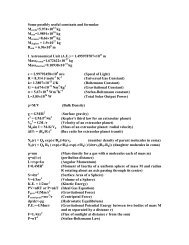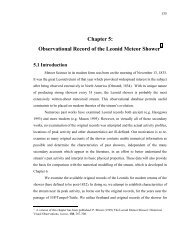Edwards W.N., Brown P.G., Weryk R.J., ReVelle D.O.
Edwards W.N., Brown P.G., Weryk R.J., ReVelle D.O.
Edwards W.N., Brown P.G., Weryk R.J., ReVelle D.O.
You also want an ePaper? Increase the reach of your titles
YUMPU automatically turns print PDFs into web optimized ePapers that Google loves.
222 W. N. <strong>Edwards</strong> et al.<br />
Klekociuk et al. 2005; <strong>Edwards</strong> et al. 2006). Yet similar infrasonic observations of smaller<br />
(\10 cm diameter) meteoroids remain rare: only a handful of these are fully documented<br />
(Kraemer 1977; <strong>Brown</strong> et al. 2007). Other observations of infrasound from small meteoroids<br />
tend to be coincident signals that are detected after a bright meteor event but lack<br />
trajectory information—this limits confidence in these associations (McIntosh et al. 1976;<br />
<strong>ReVelle</strong> and Whitaker 1999; Le Pichon 2002). With the sparseness of this dataset the result<br />
is that fundamental meteor infrasound theory (<strong>ReVelle</strong> 1974, 1976) and its predictions<br />
have remained generally untested and unconstrained by observation for more than<br />
30 years.<br />
To address this need, an ongoing coordinated campaign is underway using the Southern<br />
Ontario Meteor Network’s (SOMN) all-sky camera system, the Canadian Meteor Orbit<br />
Radar (CMOR) and the newly installed Elginfield infrasonic array (ELFO) to monitor<br />
meteor generated infrasound from common regional meteor events. Such events refer to<br />
modestly bright fireballs (–2 and brighter) and have the advantage that they are at close<br />
range to the observing station such that the acoustic signal is not significantly attenuated or<br />
dispersed. Typical ground-projected distances are within *200 km (depending on meteor<br />
altitude) or before the acoustic/infrasonic sound refracts back up into the atmosphere due to<br />
the tropospheric temperature/sound speed gradient. The goal of this long-term campaign is<br />
to determine or constrain: (1) the flux of infrasound producing meteoroids at the Earth’s<br />
surface, (2) the altitudes at which these infrasonic waves are being generated, (3) the<br />
fundamental physics of shock production during hypersonic flight of meteoroids and<br />
(4) the relationship between a meteoroid’s kinetic energy and surface observations of<br />
period and amplitude. The following sections will describe the preliminary results of the<br />
first 1½ years of this campaign.<br />
2 Equipment and Methodology<br />
The equipment used in this campaign are all component parts of the SOMN. This includes<br />
six all-sky video meteor cameras (<strong>Weryk</strong> et al. 2007), CMOR (Jones et al. 2005) and the<br />
four element infrasound station ELFO located in Elginfield, Ontario (43.1907°N,<br />
81.3152°W, 322 m, Fig. 1). These first two systems provide triggers for potential infrasound<br />
producing meteors and direct when to search for signals in the continuous pressure<br />
data logged by ELFO. In the case of the SOMN all-sky cameras, these triggers are bright<br />
visual meteors (MP \ –2), while for CMOR, they are obvious cases of meteor head-echo<br />
detection (i.e. radar reflections from the plasma surrounding the meteoroid which are<br />
automatically detected at a rate of *3/week).<br />
In the case of potential meteor detection the analysis methodology to confirm the<br />
observation and detection is as follows:<br />
(1) All-sky camera (multi-station): Event time, trajectory, radiant, light curve, velocity<br />
and mass are determined using standard reduction methods (Ceplecha and McCrosky<br />
1976; Ceplecha 1987; Ceplecha et al. 1998; Borovička 1990).<br />
(2) All-sky camera (single-station): Event time and direction are determined.<br />
(3) Radar detection: Event time, range rate, duration and signal interferometry are<br />
recorded and used to determine 3D meteor trajectory and velocity.<br />
(4) Comparison: Observed infrasonic back azimuth and propagation time are compared<br />
to the range and direction to the observed meteor trajectory. If these are found to be<br />
consistent with the meteor source, the event is logged as a probable detection.<br />
123





